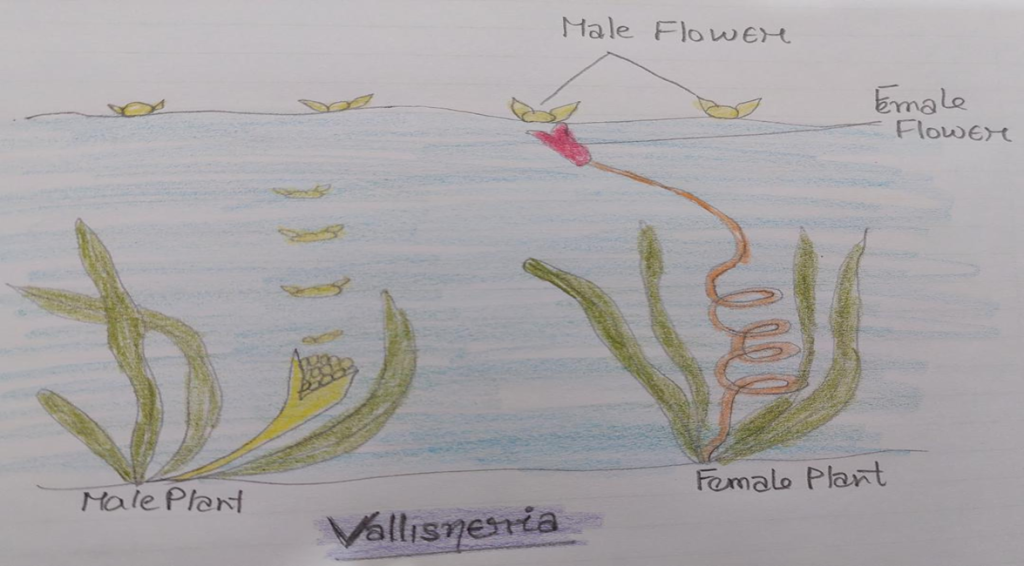AGENTS RESPONSIBLE FOR POLLINATION
In cross pollination the pollens are transferred from one plant to another by agents. These agents are:
1.Abiotic such as water wind
2. Biotic are animal pollinators.
Anemophily : In this pollination the transfer of pollen from anther of one plant to the stigma of other plant takes place by the agency of wind.
CHARACTERS OF WIND POLLINATED PLANTS
1.Flower are small, colourless, nectarless & odourless.
2. Calyx corolla are absent & if they are present then are reduced.
3.In unisexual flower the male flower are more in no. than female flower & in bisexual flower have large no. of stamen.
4.Pollen grains are small light weight dry and sometimes winged.
5.Pollen grains are produced in large no.
6.Flowers are well exposed in air.
7.Stigma are large well exposed hairy to catch the pollen grain.
8.In some plants the anther burst in the air to throw the pollen into air.
9.Ex. Grasses, Bamboo, Cannabis , maize.
Hydrophily : Transfer of pollen grain from anther of one plant to the stigma of other plant by the agency of water.
CHARACTERS OF WATER POLLINATED PLANTS
1.Flower are small, colourless, nectarless & odourless.
2.Calyx corolla pollen grain and stigma are unwettable.
3.Stigma are long and sticky.
4.Pollen grains are produced in large no.
•SOME EXAMPLES OF HYDROPHILY
•In Zostera marina the pollen grain long elongated without exine and float below the surface of water when they touch the stigma they coil around & germinate.
•In Ceratophyllum demersum a submerged plant the anther abscise at the base rise upward reach to the surface of water and dehisce and germinate while sinking in water they come in contact with stigma .
Vallisneria a submerged plant with male and female flower born on different plants . Mature male flower detach from the plant and float on the surface of water and mature female flower also float on the surface but remain attached to the plant the male flower come in contact with the female sticky trifid stigma where they liberate pollen and pollination takes place.

•Entomophily : Transfer of pollen grain from anther of one plant to the stigma of other plant by insects like bees wasp moth butterflies etc.
•CHARACTERS OF INSECT POLLINATED PLANTS
1.They are large and showy.
2.They produce nectar and scent.
3. Sometime they resemble any insect.
4.They are of different colours to attract insects.
5.Pollen grains of some plants are edible.
6.The outer surface of pollen grain may be rough spiny or sticky. They have yellow sticky substance called pollenkit which act as insect attractant
SOME EXAMPLES OF ENTOMOPHILY :
Salvia: In salvia protandry takes place that means stamen mature first. In Salvia corolla is two lipped structure the lower lip provide platform for insect that visit the flower to take nectar .The anther has two parts small sterile which block the path of insect and large fertile both are connected by connective When insect visit the flower and pushes the sterile part the fertile anther shed the pollen on its back and this pollen laden insect when enters the other flower in the entry point its wings touches the sticky stigma & hence pollen got transferred.

Yucca: In this we can see a obligatory symbiosis relationship. The pollinator Tageticula collects pollen in the form of ball and it lays eggs in the ovary of plant and pushes the pollen ball into the stigma.
Orchids : These bear the flower that resemble the Female wasp of Colpa aurea The male wasp try to pseudocopulate the flower and bring about pollination.
Ficus: Blastophaga pollinate the hypanthodium of Ficus. The wasp lay eggs in the hypanthodium and when they come out of the hypanthodium they drop pollen from male flower to female flower stigma.
ORNITHOPHILY: Transfer of pollen grain from anther to stigma of different plants by birds.
CHIROPTEROPHILY : Transfer of pollen grain from anther to stigma of different plants by bats. The flower are large dull coloured and have strong scent. Ex. Adansonia
